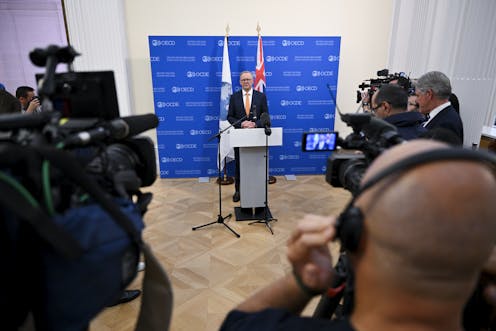Australia's media improve on diversity – but there's still a long way to go
- Written by Sora Park, Professor of Communication, News & Media Research Centre, University of Canberra

Australian media have been widely criticised for not representing the diversity of the community they speak to and write for – nor, importantly, the people they report on. Our latest research[1] shows that while the news industry is beginning to address its lack of diversity, there is still much work to be done.
Findings are showcased in the Valuing Diversity in News and Newsrooms[2] report, released today. The analysis is based on a national online survey of 2,266 Australians and 196 journalists, combined with in-depth interviews with 27 journalists about their views on diversity in the news and in newsrooms.
Australia is a multicultural country[3]. Half (48%) the population has at least one parent born overseas. Almost one-third (28%) were themselves born overseas. One in four lives in a non-English-speaking household.
However, the report shows only 39% of Australians believe everyone is treated equally, regardless of their ethnic or cultural background.
A key reason respondents may feel this is a sense of not being seen or heard in the news. Feeling equally valued and heard is an essential ingredient of social cohesion.
However, when asked about fairness and amount of coverage, less than half (46%) say the news covers culturally diverse people fairly. Only 44% say there is enough coverage of issues relevant to them, while 41% say the news is impartial and unbiased when reporting on these groups. These figures drop significantly among audiences from non-European, non-Anglo or Indigenous backgrounds.
Most Australians consider the news media to be doing a good job of covering the most important stories of the day (76%) and reporting stories accurately (70%). However, only around half say that news organisations are doing a good job of giving voice to the underrepresented (54%), with 38% saying they are doing a bad job at this.
Journalists are generally critical of the state of diversity in the industry. Only 30% of journalists say there is enough ethnic or cultural diversity in their news organisation. Around one in ten say they have experienced discrimination based on their ethnic or cultural background, and 47% of women journalists say they have experienced discrimination because of their gender. Only around half say their news organisation is doing a good job of producing news content for ethnically diverse audiences.
Why are we not seeing diversity in the news? Some of the answers can be found in the structure, practices and cultures of news organisations.
First, there are simply too few people from different cultural backgrounds in newsrooms across Australia.
According to Census 2021[4], only about 9% of journalists are from a non-Anglo or non-European background. A study that analysed 103 news programs[5] over two weeks in June 2022 found 78% of presenters, commentators and reporters had an Anglo-Celtic background.
Second, competing news values often push diversity down the priority list.
Most journalists we interviewed agreed inclusive reporting is good journalism. In the survey, we asked journalists which area of newsroom diversity they would like to prioritise: “ethnic and cultural diversity” was ranked the top.
However, when they are on the job and making reporting decisions, understandably they prioritise relevance to their audience (91%) first. Compared to other news values such as exclusivity (47%), capturing attention (42%) or surprise and novelty (38%), only 29% say it is very or extremely important that news includes voices from multicultural communities.
Third, the “glass ceiling and sticky floor” phenomenon is persistent. We found people from ethnically or culturally diverse backgrounds seeking a career in journalism continue to face discrimination.
Overall, 43% of journalists agree there are barriers to getting a job in their organisation because of ethnic or cultural background. And the majority (69%) of journalists from non-Anglo/non-European backgrounds say they have experienced barriers to career progression because of their ethnic or cultural background.
More than two-thirds “somewhat” or “strongly agree” their organisation’s junior level is doing a good job with employee diversity (67%). In stark contrast, only 23% “somewhat” or “strongly agree” that senior levels at their organisation are doing well with employee diversity.
Fourth, there is not enough training and support from the organisation.
Over half (52%) of journalists say their news organisation has policies relating to language use about ethnically diverse communities. About half (49%) also say their organisation collects or monitors staff diversity. However, only 39% received training on how to cover issues of diversity in the past year.
The journalists we interviewed cautioned against inclusion as a “box-ticking” exercise, and labelling people from diverse backgrounds. A journalist from an Asian background talked about an inclusivity workshop where participants were all non-white, emphasising the importance of making sure journalists from all cultural backgrounds receive adequate training.
News organisations have made significant efforts to improve newsroom diversity in recent years. Despite this, we still have a long way to go in shifting the culture, removing unconscious bias and making space for journalists from diverse cultural backgrounds.
Trust and engagement with the news media are directly related to audiences’ perceptions of adequate and fair representation[6]. So for news organisations seeking to regain audience trust, it is vital to have journalists from diverse cultural backgrounds telling stories from their experience.
References
- ^ latest research (www.canberra.edu.au)
- ^ Valuing Diversity in News and Newsrooms (doi.org)
- ^ multicultural country (www.abs.gov.au)
- ^ Census 2021 (www.abs.gov.au)
- ^ study that analysed 103 news programs (www.sydney.edu.au)
- ^ adequate and fair representation (apo.org.au)
















